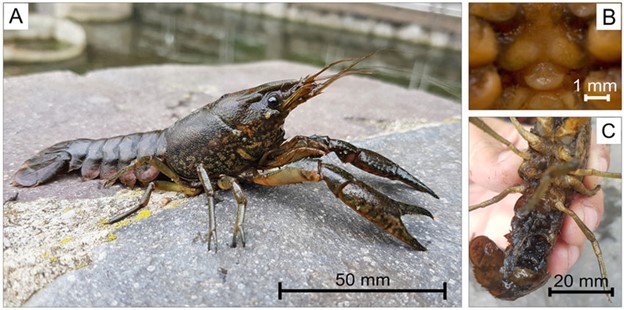Marbled crayfish
Learn more about marbled crayfish and how you can help prevent the introduction and spread of this invasive species.
Marbled crayfish found in Ontario
Marbled crayfish was found in a pond in the Burlington, Ontario area.
This is the first time marbled crayfish has been found in the wild in Canada. The ministry and our partners are investigating to learn more.
If you see marbled crayfish or another invasive species in the wild:
- call the toll-free Invading Species Hotline at
1-800-563-7711 - report it online or with your mobile device using EDDMapS
What Ontario is doing
To prevent this unwanted invader from coming into the province, Ontario has regulated marbled crayfish (Procambarus virginalis) as a prohibited invasive species under the Invasive Species Act, 2015.
Learn about the Invasive Species Act and regulations.
Background
The marbled crayfish, also known as marmokrebs, is an invasive crayfish which is suspected to have been created accidentally within aquariums.
It is an all-female species which reproduces through clones that are genetically identical to the mother without the need for sperm or a fertilized egg.
They are found to survive in many different environments, including countries with climates like Ontario.
Marbled crayfish are relatively popular in the aquarium trade, which provides the main source of spread to new areas through release into local waterways.
Because the marbled crayfish does not require sexual reproduction, a new population can become established in new area with the release of only one individual.
Range
The marbled crayfish was first discovered in the German aquarium trade in the mid 1990s and has since become established in many locations across the country.
Since then, this species has been released and is established in nine European countries, as well as Madagascar and Japan.
In 2023, marbled crayfish was found near Burlington, Ontario. This is the first known occurrence of this species in Canada outside of captivity. The ministry and our partners are investigating this occurrence to learn more.
View an up-to-date distribution map of this species in North America.
Impacts of marbled crayfish
Because they reproduce asexually (without the need for sperm or a fertilized egg), marbled crayfish can rapidly take over an area.
Marbled crayfish can outcompete small native aquatic species for food and habitat. If they become established in Ontario, they could replace native crayfish, which are already being impacted in parts of Ontario by the invasive rusty crayfish.
Marbled crayfish have generalist diets that can lead them to overconsume aquatic vegetation. They may also impact Ontario’s biodiversity by feeding on algae, plants, invertebrates and amphibians.
Overconsumption of invertebrate and fish eggs may negatively impact food availability, disrupting food webs and Ontario’s recreational and commercial fisheries.
Abundant numbers of these crayfish may also destabilize shorelines through the creation of their burrows on riverbanks.
How to identify marbled crayfish
- A medium-sized crayfish is 3 to 10 cm in length.
- Body can be dark brown, tan, brown-green or sometimes blue, always with marble patterning.
- Juveniles develop spotted pigmentation and possess more marble patterning in adolescence.
- Between the legs under the crayfish there is a sperm receptacle, known as the annulus ventralis. It is a flat and bell-shaped structure that can differentiate marbled crayfish from other species.
What you need to know
- Learn how to identify marbled crayfish and how to prevent the introduction or spread of this animal through the aquarium trade.
- It is against the law to import, possess, deposit, release, transport, breed/grow, buy, sell, lease or trade marbled crayfish in Ontario.
- Never buy, keep or breed marbled crayfish as a pet or for any other purpose. You cannot keep marbled crayfish in an aquarium. They may be listed for sale under other names such as marble crayfish, self-cloning crayfish or marmorkrebs.
- Never release plants or animals into the natural environment. This can unintentionally start an invasion that will negatively affect Ontario’s native species.
- If you need more information, including how to properly dispose of marbled crayfish, email us at invasive.species@ontario.ca.
Reporting illegal activity
If you have any information about the illegal importation, distribution, or sale of marbled crayfish, report it immediately to either:
- the ministry at
1-877-847-7667 , toll-free anytime - Crime Stoppers anonymously at
1-800-222-TIPS (8477)
If you’ve seen marbled crayfish or another invasive species in the wild, please:
- contact the toll free Invading Species Hotline at
1-800-563-7711 - visit EDDMapS Ontario
- search for the ‘Invasive Species in Ontario’ project on iNaturalist.org to report a sighting
Gallery
Marbled crayfish specimen (A), close up of the Annulus ventralis (B), and carried stage two juveniles (C) (From Togor et al. 2017)
